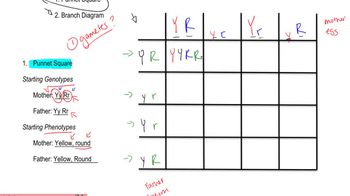Here are the essential concepts you must grasp in order to answer the question correctly.
Dihybrid Cross
A dihybrid cross involves two traits, each controlled by different genes, typically represented by two pairs of alleles. In this case, the genes R and T are being studied, where each gene can have a dominant or recessive allele. The phenotypic ratios observed in the offspring (F₂ generation) arise from the independent assortment of these alleles during gamete formation, leading to a variety of combinations in the progeny.
Recommended video:
Phenotypic Ratios
Phenotypic ratios describe the relative frequencies of different phenotypes in the offspring resulting from a genetic cross. In the given scenario, the ratio of 9/16 green, 3/16 yellow, 3/16 blue, and 1/16 white indicates how the interactions between the alleles of genes R and T influence pigment production. Understanding these ratios is crucial for predicting the outcomes of genetic crosses and the underlying genetic mechanisms.
Recommended video:
Gene Interaction
Gene interaction occurs when the effects of one gene are modified by one or more other genes, leading to a combined effect on the phenotype. In this case, the dominant alleles of genes R and T catalyze different reactions that contribute to pigment production from a colorless precursor. The specific interactions between these genes can result in various phenotypes, as seen in the diverse ratios of the F₂ progeny.
Recommended video:
Interacting Genes Overview






